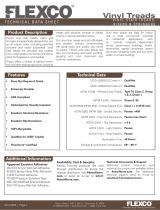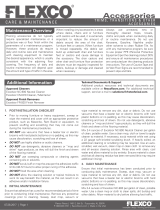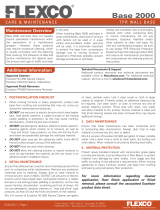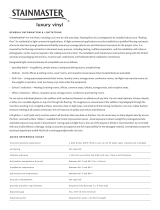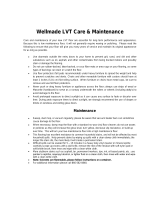
09.1.2017 | Page 3
Flexco Floors | 1401 E. 6th St. - Tuscumbia, AL 35674
P: 800.633.3151 | flexcofloors.com | Made in the USA
TECHNICAL DATA SHEET
RUBBER TILE
Distinct Designs
heat sources, such as radiators, ovens
or other high-heat equipment. May be
susceptible to staining from rubber tires,
casters or rubber-backed walk-off mats,
as well as harsh disinfectants, cleaning
agents, dyes or other harsh chemicals –
ensure all chemicals and materials that
may come in contact with flooring surface
will not stain, mar or otherwise damage
the flooring material prior to use.
3. SUBSTRATE PREPARATION
All substrates must be prepared according
to ASTM F710, as well as applicable ACI
and RFCI guidelines. Substrates must
clean, smooth, permanently dry, flat, and
structurally sound. Substrates must be
free of visible water or moisture, dust,
sealers, paint, sweeping compounds,
curing compounds, residual adhesives
and adhesive removers, concrete
hardeners or densifiers, solvents, wax,
oil, grease, asphalt, visible alkaline salts
or excessive efflorescence, mold, mildew
and any other extraneous coating, film,
material or foreign matter.
All substrates must have any and all existing
adhesives, materials, contaminants or
bond-breakers mechanically removed
via scraping, sanding, grinding or buffing
with a 25 grit DiamaBrush Prep Plus tool
prior to adhesive installation. In extreme
situations, shotblasting may be required.
Mechanical preparation must expose
at least 90% of the original substrate.
Following cleaning and removal, all
substrates must be vacuumed with a flat
vacuum attachment or damp mopped with
clean, potable water to remove all surface
dust. Sweeping without vacuuming or
damp mopping will not be acceptable.
All porous substrates must be tested per
ASTM F3191 to confirm porosity. Use a
pipette or equivalent to conduct three
tests by placing a .05 mL (1/4” wide)
droplet of clean, potable water onto the
surface. If the substrate absorbs water
within 60 seconds, the substrate is
considered porous. Conduct 3 tests for
the first 3000 sq. ft. and one for each
additional 2000 sq. ft., at least one per
room. All other substrates that do not
meet this requirement are considered
non-porous. Ensure that all non-porous
substrates are not contaminated with any
aforementioned contaminates.
It is recommended that all substrates
have a floor flatness of FF32 and/or a
flatness tolerance of 1/8” in 6’ or 3/16”
in 10’. Substrates that do not meet this
requirement should have a compatible
cementitious patch (such as the Excelsior
CP-300) or self-leveling underlayment
(such as the Excelsior SU-310) installed to
flatten the installation area.
Do not use solvent/citrus based adhesive
removers prior to installation. Follow
The Resilient Floor Covering Institute’s
(RFCI) “Recommended Work Practice for
Removal of Existing Floor Covering and
Adhesive”, and all applicable local, state,
federal and industry regulations and
guidelines. When removing asbestos and
asbestos containing materials, follow all
applicable OSHA standards.
CONCRETE SUBSTRATES
All concrete must have a minimum
compressive strength of 3500 PSI and
be prepared in accordance with ASTM
F710. When flooring is being installed
directly over concrete, concrete surfaces
that have an ICRI Concrete Surface Profile
(CSP) over 4 should be smoothed with
a self-leveling underlayment (such as
the Excelsior SU-310) or a cementitious
patch (such as the Excelsior CP-300) to
prevent imperfections from telegraphing
through flooring materials. On or below
grade concrete must have a permanent,
effective moisture vapor retarder installed
below the slab.
New or existing concrete substrates on all
grade levels must be tested in accordance
with ASTM F2170, using in situ Probes, to
quantitatively determine the amount of
relative humidity no more than one week
prior to the installation.
In addition to ASTM F2170 Relative
Humidity Testing, existing concrete that
1. PRE-INSTALLATION CHECKLIST
• Consult all associated product
literature concerning adhesive
installation, maintenance and
warranty prior to installation of
flooring.
• Allow all trades to complete work
prior to installation.
• Deliver all materials to the installation
location in its original packaging with
labels intact.
• Do not stack pallets to avoid damage.
• Remove any plastic and strapping
from product after delivery.
• Inspect all material for proper type,
color and matching lot numbers if
appropriate.
• Ensure that all adhesives intended for
installation are approved for use with
flooring material.
• Ensure installation area and material
storage temperatures are between
65° F (19° C) and 85° F (30° C) for
at least 48 hours before, during and
after installation.
• Ensure HVAC system is operational
and fully functioning at normal
operating conditions.
• Protect installation area from extreme
temperature changes, such as heat
and freezing, as well as direct sunlight
for at least 48 hours before, during
and after installation.
• Ensure all substrate preparation
and moisture testing requirements
have been performed, read and/or
understood by all interested parties.
• Do not proceed with installation until
all conditions have been met.
2. PRODUCT LIMITATIONS
Do not install materials over LVT, cushioned
vinyl, hardwood flooring, cork, rubber, or
asphaltic materials. Do not install flooring
materials in outdoor areas, residences,
in or around commercial kitchens or
areas that may be exposed to animal fats
animal or vegetable fats and oils, grease
and petroleum-based hydrocarbons. Do
not install in areas that may be subjected
to sharp, pointed objects, such as stiletto
heels, cleats or spikes. Do not allow
product to be directly exposed to extreme
Adhesive RH Limits
SP-500 Acrylic Aerosol: 90% RH
AW-510 Acrylic Wet-Set: 90% RH
AP-520 Acrylic Roll-On: 80% RH
MS-700 Modified Silane: 95% RH
EW-710 Epoxy Wet-Set: 90% RH






